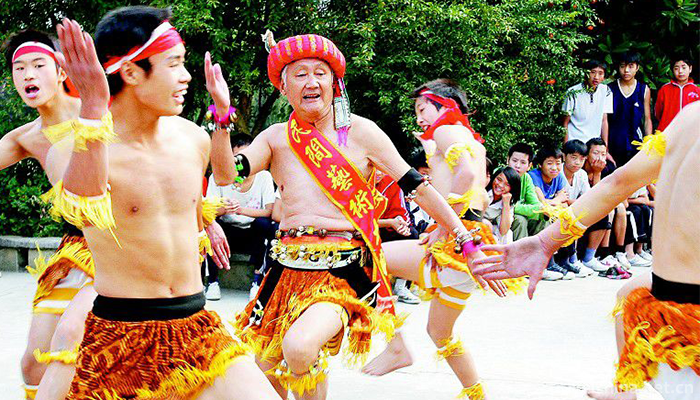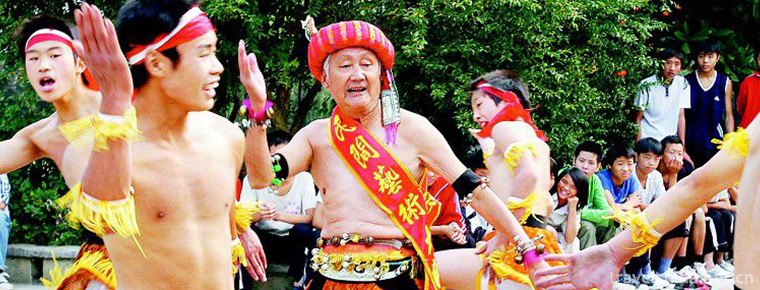Meat rustles
Meat rustles
"Meat Lianliang" refers to the native minority local dance variety in Lichuan City, Hubei Province, which takes the unique body performance as the main form. It is popular in the city's Duting, Boyang and Wangying areas. The dance is named for the rhythmic sounds emitted by the forehead, shoulder, face, arm, elbow, waist, leg and other parts of the palm.
"Meat Lianliang" used to be called "Meat Lianxiang", which is similar to the traditional folk dance "Da Lianxiang". Because dancing is featured by the sound of its physical touch, the villagers are accustomed to call it "flesh sound". "Meat Lianliang" dance is humorous and lively, which is welcomed by the masses. However, because of the difficulty in performing and the high demand for action, there are few practitioners.
On June 7, 2008, Lichuan City of Hubei Province declared that "Meat Lianliang" was listed in the second batch of national intangible cultural heritage list with the approval of the State Council. Heritage serial number: 649 III-52.
artistic characteristics
Art Development
Before liberation, "meat ringing" was only a means of begging. The purpose of the performance was to win the joy and sympathy of the host and hope for charity. After liberation, according to Wu Xiufu, a 78-year-old master of folk art, who taught a group of young masters by his own words and deeds, the "Meat Lotus Sound" gradually became one of the ethnic folk dances for Tujia villagers to celebrate the harvest and activate the market. In the process of inheritance and development, "Meat Lotus Sound" has blended into folk dance movements and charm such as Yangko Dance, Playing, Funeral Dance, Bamboo Lotus Hunan, and correspondingly matched with the music tune of "Lotus Flower". The lyrics are compiled and sung by dancers according to their needs, so as to make them more full of interest and the audience's on-the-spot interactive mood, and gradually developed into a kind of song. The unique popularity and rooted in the people's folk dance.
Performing Form
"Meat Ring" is mostly performed by men. The venue is open to all sizes. Because of the close relationship between movement and sound, the performers only wear vest, shorts or bare arms. They need neither props nor more clothes, so they are easily accepted by most people. Its main movements are "Yangkobu", "Put on your hands and suck your legs", "Turn around with trembling steps", "Doubles", "Ten Rings", "Seven Rings", "Four Rings" and "Three Rings". The performance of "Meat Ring" is lively, humorous, lively and free. In terms of rhythm, we should pay attention to "circular rotation" and constantly change the body tilt angle along the position of the collision, so as to harmonize gently and beautifully. Although there is no singing cavity or accompaniment, the oral reading is short and has its own characteristics. According to the needs of singing, the artist adds the sound accompaniment of tongue, which adds to the joyous atmosphere of dancing.
Inheritance and Protection
In Lichuan Mountain City, there is a well-known "Wu referee". He is famous for playing amateur basketball referee for many years. Everyone knows that he can jump meat repeatedly.
The name of Wu Judge is Wu Xiufu, a Tujia nationality. He was born in Lichuan City on October 12, 1928, on the lunar calendar. When he was thirteen years old, he went to Duting Primary School. He read three times and four times directly, and only read for one year. Then I went to the newspaper twice to work as a printer and a miscellaneous worker. At the beginning of the liberation, he served as a soldier for three years in Western Hubei, mainly on guard for the special department. He has been engaged in haircutting all his life. He started to use a razor at the age of 17. He has been skilled for more than 50 years. After his haircut, he became an amateur referee and served the basketball court enthusiastically.
Wu Xiufu loved literature, art and sports from childhood. When he studied haircut, he often went to the theatre to play basketball. He was often scolded by his master. At that time, there were often folk artists performing in the city. Wu Xiufubian watched and learned about Dragon Boat tune, play and Lianxiang. He learned very well. Sometimes I have learned to ask artists for Lyric materials. I often spend a lot of time with others until I get what I want. When Wu Xiufu was young, Mou, a barber with him, often learned to do the "clay God way" action. The "clay God way" is a way of begging for money by the poor in the old society. The beggars were naked and covered with mud. They were beaten with both hands and splashed with mud. Where the beggar goes, which one is forced to give money to make the beggar leave early. Wu Xiufu saw that it was interesting for Master Mou to learn to do the "clay God way" and imitated it. As long as the haircut is idle, he compares and deliberates on his dancing skills. He often stripped naked, clapped his hands on his body, hummed and sweated. Numerous exercises, countless guesses, made him have a strong interest in this dance, and formed a certain routine. Later, he tried to integrate Yangko dance, juggling, funeral dance, Lianxiang and other folk dances into a rhythmic sound by tapping shoulders, arms, forehead, elbows, crotch, legs, feet and other parts. Its dance movements and sound effects are similar to those of Da Lianxiang. Because no props are used, only rhythmic sounds occur when the hands contact with various parts of the body, people call this dance "flesh continuous sound". As soon as he was free, Wu Xiufu wrote and practiced by himself to entertain himself, so as to make dancing movements skillful and stereotyped. As soon as he had the chance, he showed his hands and made numerous public appearances, which gradually influenced and formed the climate.
It is precisely because of his outstanding contribution to the inheritance of meat for many years that he was awarded the honorary title of "Master of Folk Art" in Enshi Autonomous Prefecture.


-
1.Gold medal suckling pig
Roasted Suckling Pig. Characteristic: It has won the "Golden Ding Award" by the national commercial department. It is a precious Cantonese dish at the banquet.
Time 2018-11-14 -
2.Badachu Park
Located at the south foot of Beijing's famous Xishan scenic spot, Badadu Park is a national AAAA-level scenic spot. It is the first batch of key cultural relics protection units in Beijing after the f
Time 2018-12-24 -
3.Size Dongtian Scenic Spot
The Size Dongtian Scenic Area (formerly known as the Haishan Scenic Spot and Aoshan Scenic Spot) is located in the southern corner of Hainan Province, 40 kilometers west of Sanya City
Time 2019-01-07 -
4.Qingdao Wine Museum
Qingdao Wine Museum is located at No. 68 Yan'an Road, North District of Qingdao City. It is an underground museum with popular science education, collection and display
Time 2019-02-07 -
5.Kaiyuan Cave Tourist Area Zibo
The karst cave in Kaiyuan is named for the cliff stone carvings in Kaiyuan period of Tang Dynasty. It is large and tall with a length of more than 1100 meters. It is divided into six halls. The natura
Time 2019-03-21 -
6.Jiangnan Shaoxing opera
Yueju Opera, the second largest opera in China, is also known as "the most widely circulated local opera" . Some people think that it is "the largest local opera",
Time 2019-05-05 -
7.The story of Xie Jin
Xie Jin (Dec. 6, 1369 - Feb. 22, 1415), a literary Minister of Ming Dynasty, was born in Jishui, Ji'an Prefecture, Jiangxi Province.
Time 2019-05-06 -
8.Peony legend
Peony legend is one of the folk legends in Luoyang, Henan Province. Since Luoyang Peony became famous all over the country, myths, folklores and interesting stories have emerged one after another. The
Time 2019-06-05 -
9.Wenshui Tiaozi
Wenshui Biaozi is an ancient and unique traditional folk music art spread in Wenshui County, Shanxi Province. It is named for its special copper cymbals commonly known as "Biaozi" in perform
Time 2019-06-29 -
10.Lemon Honey Tea
Honey lemon tea is made of honey and lemon. It has many functions such as whitening, nourishing, lowering blood fat, clearing heat, detoxifying, moistening and drying. Lemon contains vitamin B1, vitam
Time 2020-03-16 -
11.The position of Panzhihua
Panzhihua City is located at the junction of Sichuan and Yunnan in Southwest China, 26 ° 05 ′ - 27 ° 21 ′ N and 101 ° 08 ′ - 102 ° 15 ′ E. Jinsha River and Yalong River meet here. It borders Huili, Dechang and Yanyuan counties of Liangshan Yi Autonomous Prefecture
Time 2020-12-14 -
12.Social undertakings in Guangyuan
In 2018, Guangyuan City achieved 31 major scientific and technological achievements throughout the year, and 1466 patents were applied, including 288 inventions and 931 authorized patents. 84 technical contracts were registered, and the transaction value
Time 2020-12-15